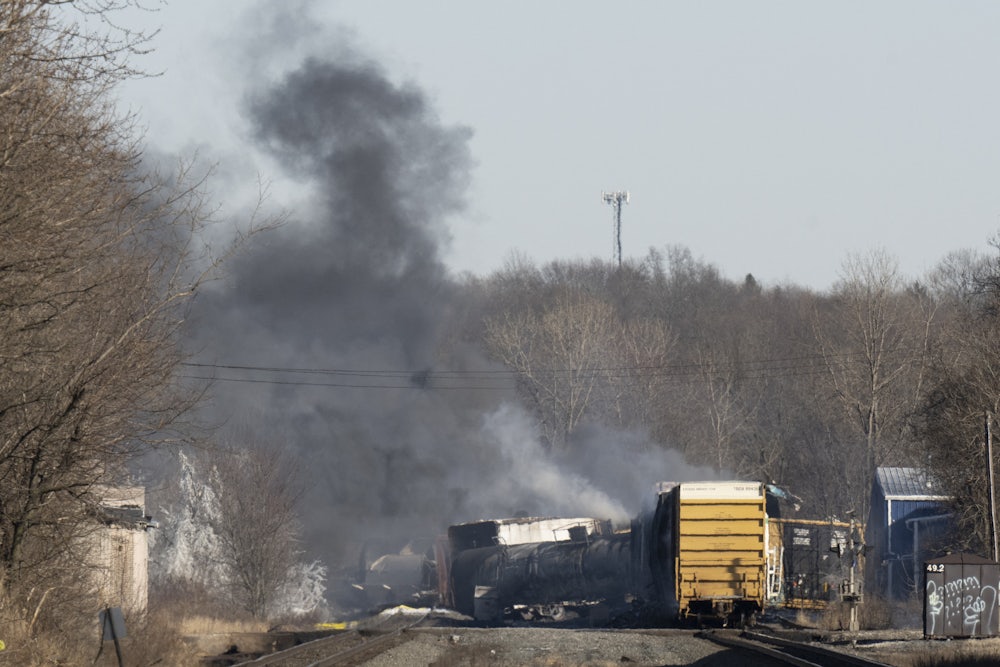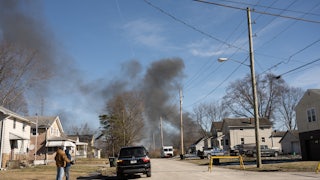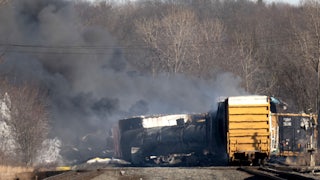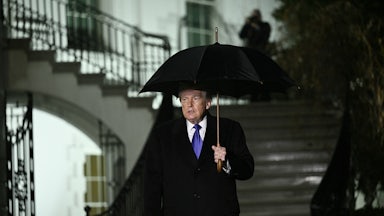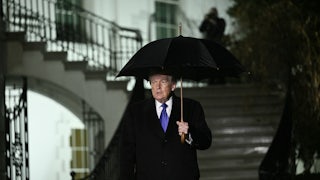On February 3, a Norfolk Southern freight train derailed near East Palestine, Ohio, a small town (pop. 4,800) situated on the Pennsylvania border 20 miles south of Youngstown. The derailment spewed vinyl chloride and other toxic chemicals into the air, killing fish in nearby streams and prompting an evacuation. Ohio Governor Mike DeWine, a Republican, warned that anyone who lingered in the immediate area
would face “grave danger of death.” Five days later, DeWine said it was safe to return home, but local residents continued to report headaches and nausea.
If all this sounds reminiscent of Don DeLillo’s 1985 novel White Noise and Noah Baumbach’s 2022 film adaptation of same, just imagine how it felt to Ben Ratner, an East Palestine resident who, along with various family members, worked as an extra on the movie when Baumbach was shooting nearby. “The first half … is all almost exactly what’s going on here,” Ratner told CNN.
We don’t yet know much about what caused the derailment, and won’t know until the National Transportation Safety Board weighs in. But to anyone familiar with the rail contract negotiated in September by Labor Secretary Marty Walsh (who’s expected to leave shortly to become executive director of the NHL Players’ Association) and ratified in December by Congress over the objection of four participating unions—to anyone who followed that Sturm und Drang—two facts stand out.
Fact One is that the Norfolk Southern train was pulling 141 freight cars. Freight trains are much longer than they used to be, and today their length can be measured, literally, in miles. That’s long been a point of contention for railway workers. “The engineer driving can’t even see the end of the train,” Jeff Kurtz, a retired locomotive engineer and an official with Railroad Workers United, complained in 2017 to the Albany Times-Union.
Fact Two is that the “crew” (all of whom, thankfully, survived the derailment) consisted of two Norfolk Southern rail workers plus one trainee. That’s 47 cars per person. Two crew members is the minimal number required on every freight train under a regulation proposed last July by the Federal Railroad Administration, or FRA. Unbelievably, there is currently no regulatory requirement on crew size.
The labor dispute that almost created a rail strike last fall was not about pay; rail workers are already paid very well, and under the new contract they’ll be paid considerably more. Rather, it was about working conditions. Rail workers were demanding that they not get penalized for taking sick days. They didn’t get any in the contract; instead they got one additional paid day off and an agreement from management not to penalize them when they go to a doctor’s appointment or have a medical procedure done.
Management was insistent that rail workers not be granted the minimally decent benefit of sick days because that would require them to hire more people, and the big “Class I” carriers are all about getting rid of workers, not hiring more. Over the past six years they’ve shed, collectively, nearly one-third of their workforce. Work crews have shrunk over the past three decades from a minimum of six people to a minimum of four to a minimum of two, even as the trains have gotten longer. Smaller work crews and longer trains are the keystones of Precision Scheduled Railroading, or PSR, the reigning gospel of Class I freight, which has made the railroads improbable darlings of Wall Street.
The railroads will tell you that in the PSR era, the overall number of rail accidents (typically derailments and collisions) has remained steady over the past decade, at about 1,000 per year. (I exclude 2020 and after, when Covid reduced the number of freight shipments.) Derailments, though, increased, from 94 in 2013 to 136 in 2019. Remember too that during this period freight’s market share lost ground to trucking. Greg Regan, president of the AFL-CIO’s Transportation Trades Department, directed me to the rate of total accidents or safety-related incidents per track mile. That rose a nontrivial 10 percent between 2013 and 2022.
For Norfolk Southern, total accidents or safety-related incidents rose on a per-track-mile basis (again, over the past decade) by 82 percent. Norfolk Southern’s workforce shrank from about 30,000 in 2015, the year it adopted PSR, to about 25,000 in 2019. Even before Covid hit, Norfolk Southern shed about 17 percent of its workforce. It shed considerably more in 2021, then started hiring again in 2022. Today Norfolk Southern’s workforce is about 19,000, or about one-third smaller than it was in 2013.
We don’t know a lot about what caused the February 3 derailment, except that it involved an axle that overheated. But what we do know raises suspicions about whether a sufficient number of human beings was paying attention to those 141 freight cars. On February 10, Anya Litvak of The Pittsburgh Post-Gazette reported that security camera footage 20 miles short of where the derailment occurred showed a rail car axle that appeared to be on fire. Why this information was not transmitted quickly to the train crew remains unknown, but it seems likely that the answer has something to do with the number of people who were in a position to sound the alarm.
Something else that jumped out to the AFL-CIO’s Regan was that Norfolk Southern does not participate in a voluntary “confidential close-call” program run by the FRA that protects rail workers who blow the whistle on accidents that are averted only narrowly. None of the major freight rail carriers do.
Nobody died in the February 3 derailment (though it will be some time before we know whether it caused a cancer cluster). That’s something to be thankful for. Freight rail is safer overall than trucks to move toxic chemicals, but when lives are at stake that isn’t good enough. A clean and healthy environment depends on many factors, and at least three of them are labor issues: whether there are enough people working to prevent toxic spills, whether they get sufficient rest between shifts, and whether they end up working while sick because they can’t get time off. At least one of these factors, I’ll wager, figured in the February 3 derailment. A safe environment requires workplace safety, and that’s especially true when the workplace in question has wheels.
